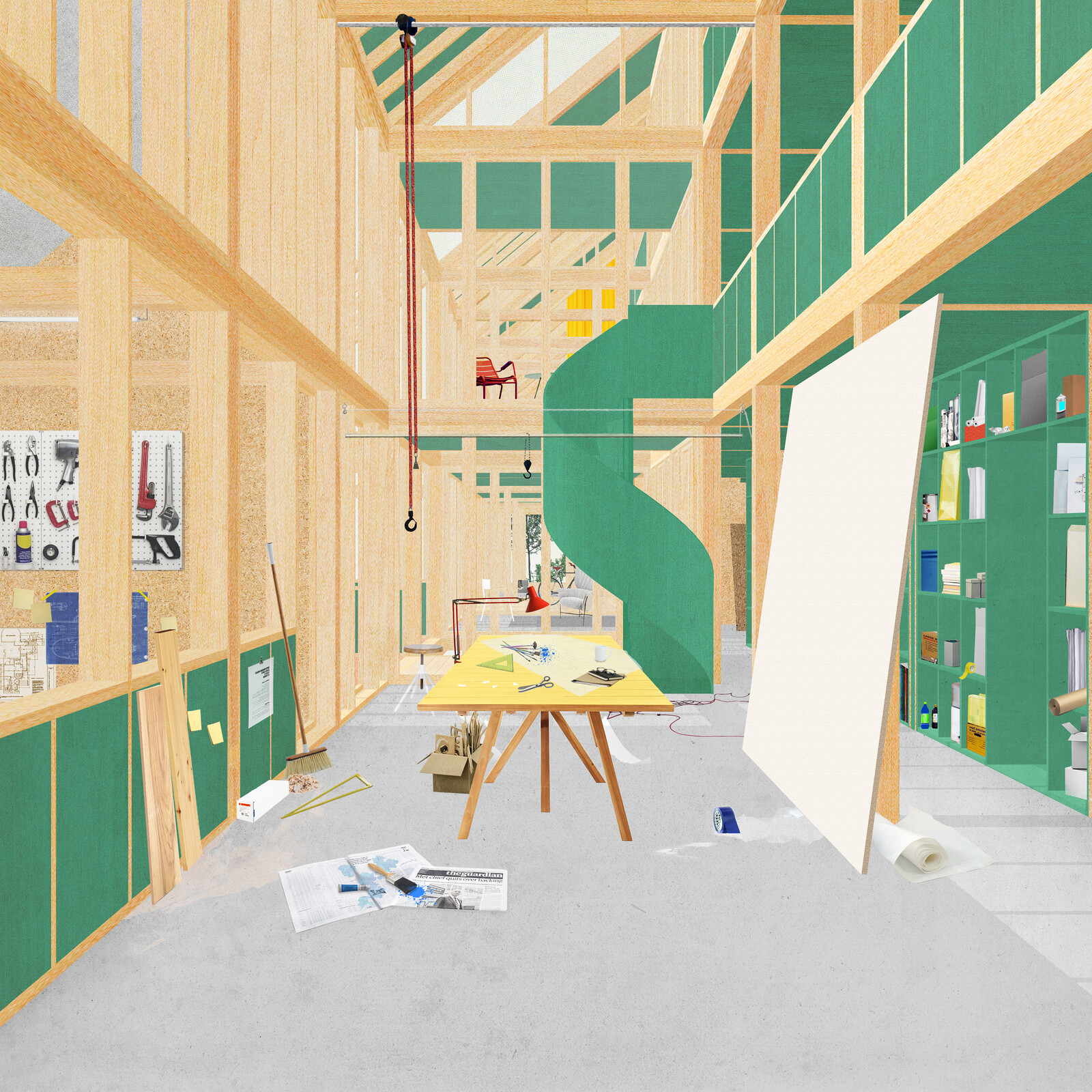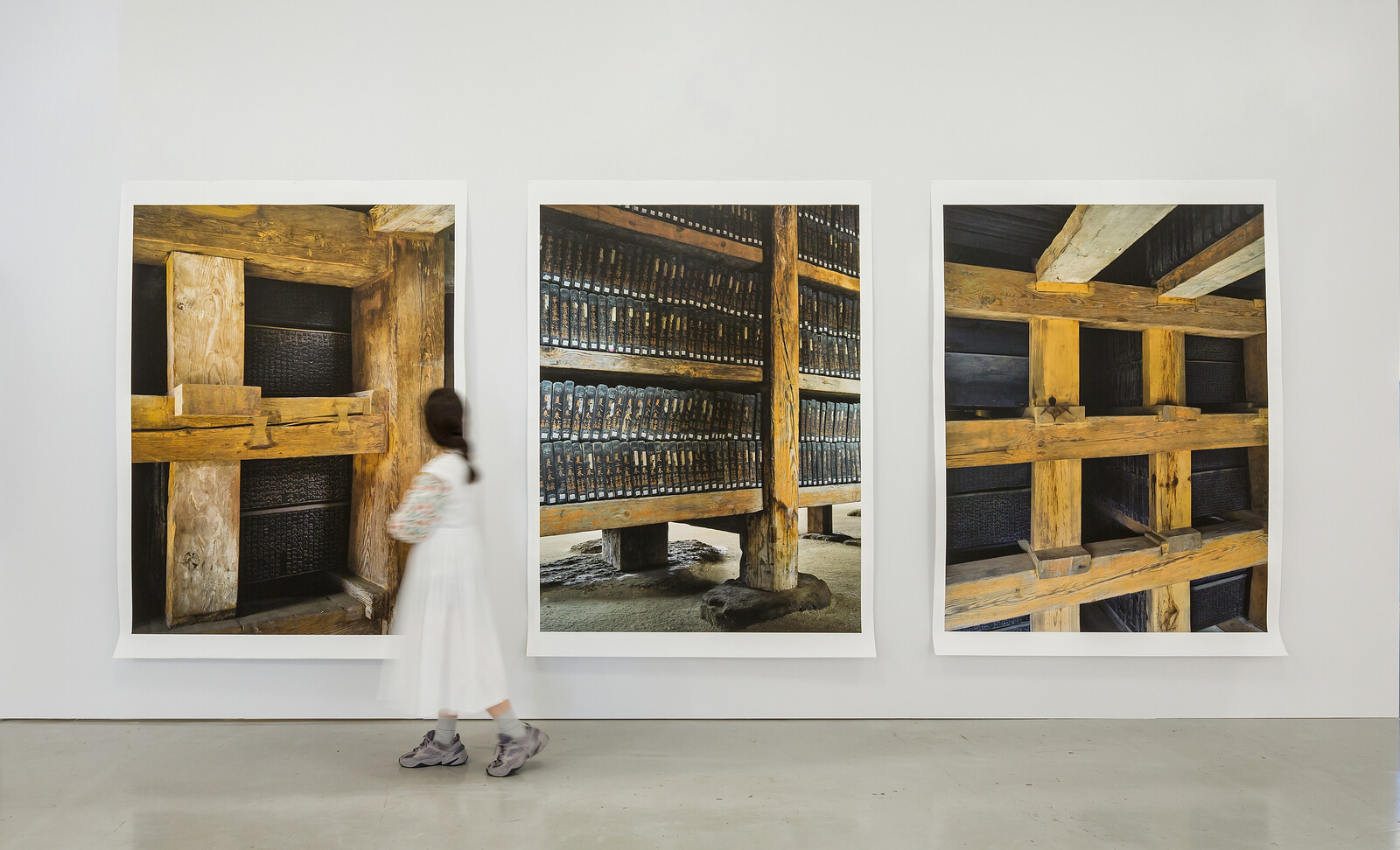The Original Sin
When addressing contemporary housing crises, it is common for architects, planners, and the public to refer to a shortage of affordable housing and social housing. What often goes missing in this assessment is the very origin of this crisis, which coincides with the long and controversial process of the privatization of land. To put it bluntly: there is no housing affordability without access to land.
The privatization of land is nothing new: it is and has always been a legalized theft perpetrated by landlords with the active support of the state. The legalized theft of land began with the rise of the nation state (specifically England) between the fifteenth and eighteenth century.1 During this period, peasants living in rural areas of England were expropriated through a process of privatization enacted by landowners who used the state to create a legal structure that revoked the peasant’s traditional rights. This was possible through a gradual process of suppression of the common field village, in which ownership of land was organized through the form of selions, or scattered pieces of arable land that farmers cultivated individually and cooperatively.2
The basis of this collective system was an informal set of rights of customs, which derived from consolidated practices concerning the occupation and use of land. Against rights of customs, landlords invoked individual property titles. Such titles, granted by the state, enabled them to unite huge swathes of land as their own private estates. This process of privatization was justified by discourses on improvement and efficiency: for landlords only a piece of land that was securely owned by one proprietor could be easily governed while increasing production.3
A crucial consequence of the transformation of land into private property was the possibility for the landowner not only to sell land as any other commodity, but also to use it as collateral for financial loans.4 Still today, lending money against landed property is the largest source of credit and money creation.5 For landlords, owning land through property titles was not just a way to extract more surplus from agricultural production, but also a way to raise capital through the use of land as a financial asset.
Since the second half of the nineteenth century in industrialized countries like England, only a relatively small fraction of the population (20%) has worked in agriculture, the rest working in manufacturing and living in cities.6 This has meant a dramatic increase of inhabitants in cities, which provides an opportunity for landowners to speculate on land for housing. Against this process of speculation, in the early twentieth century, several European states such as the United Kingdom, Sweden, and the Netherlands initiated massive purchases of land in order to support local municipalities to build social housing.
State-owned housing gained momentum postwar, when the opportunity (and necessity) for reconstruction allowed many European countries to secure enough public land for building an unprecedented quantity of public housing. Yet the years in which the state built the most were also those in which the market did the same.7
In the heyday of the welfare state, the tacit political goal of many liberal-democratic states in Europe was to build a “property-owning democracy.” Even social housing projects, with their rigidly defined housing units modelled on the nuclear family, trained dwellers in the virtues of a privately owned domestic space. Eventually, the demise of the welfare state in the 1980s pushed the privatization of social housing further, making it clear that the state as “benevolent” landlord and custodian of public good was an exception in the history of land property.
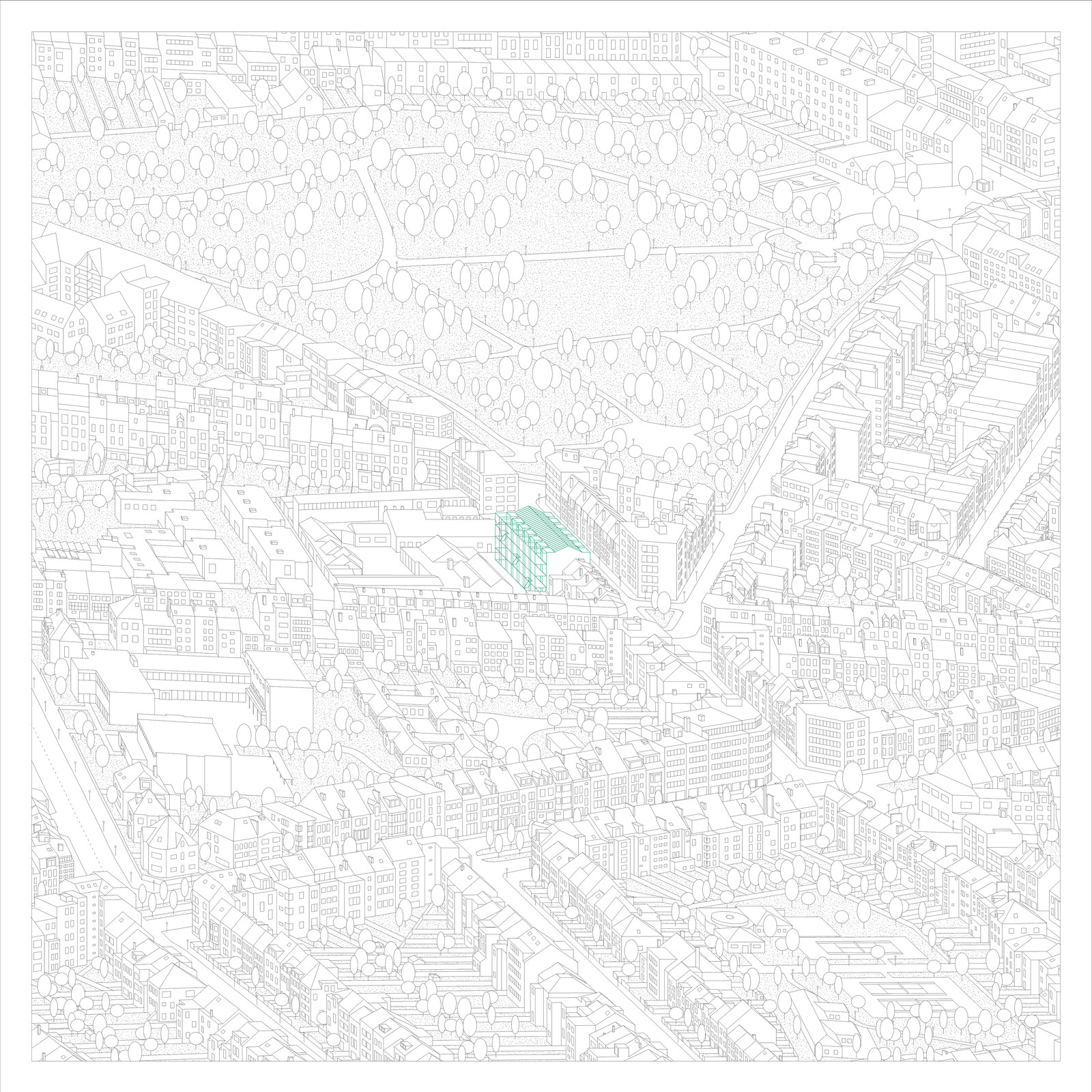
Housing for Community Land Trust in Brussels in Rue Démosthène, Anderlecht, Brussels. DOGMA, Do you see me when we pass?, 2019.
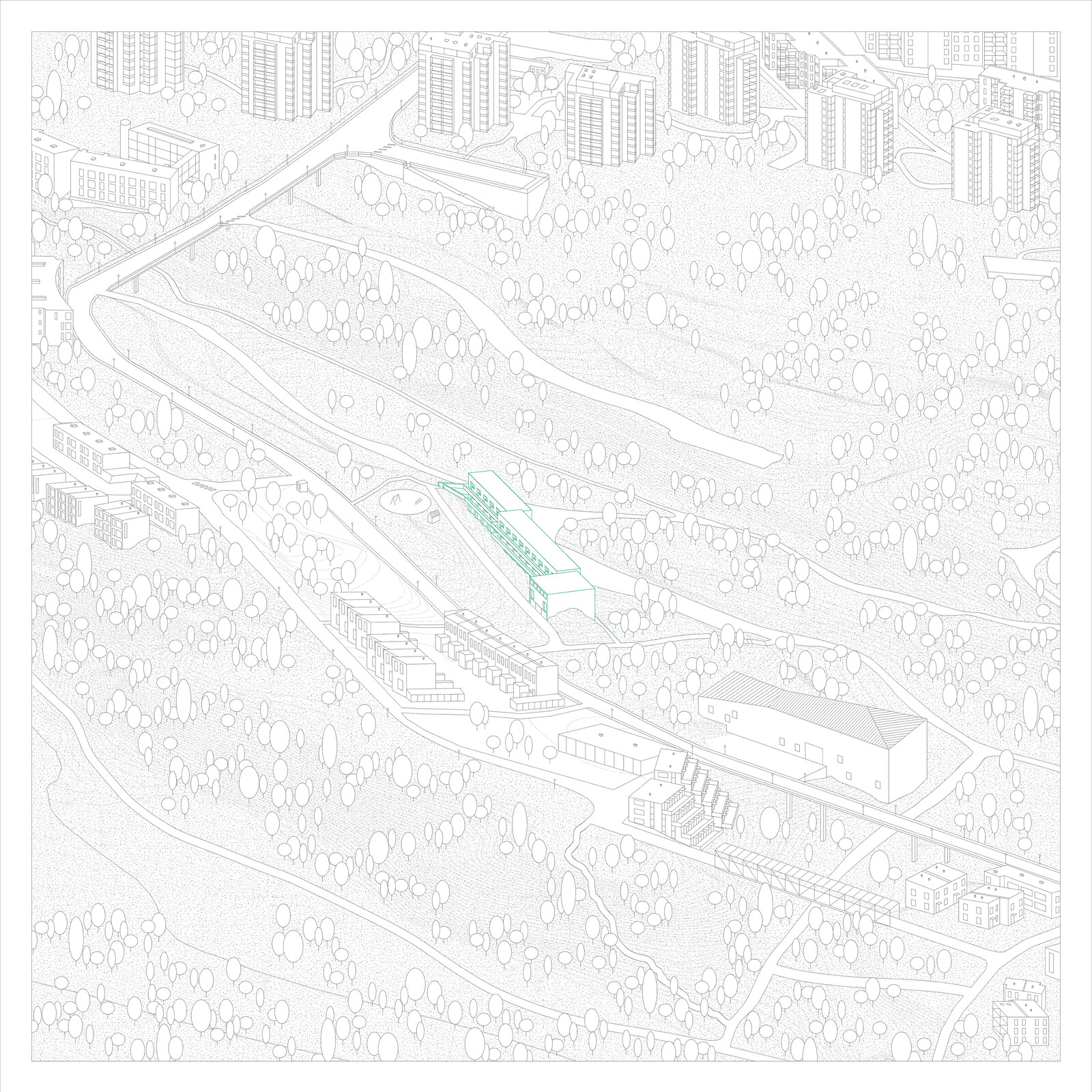
Proposal for Viikinmäki, Helsinki. New Academy, 2019.
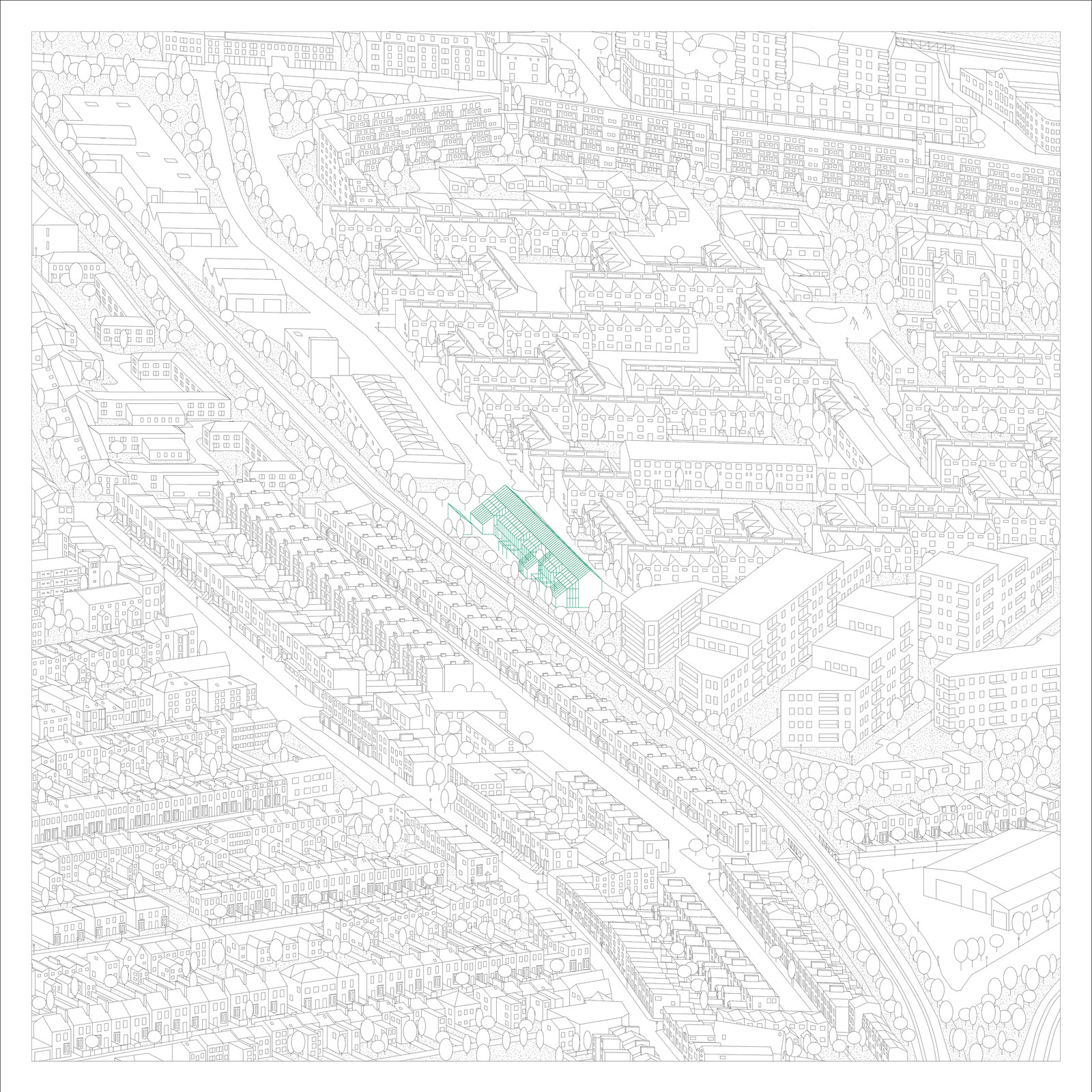
Proposal for a Cooperative House on Somerleyton Road, Brixton, London. DOGMA, Do you hear me when you sleep?, 2019.
Housing for Community Land Trust in Brussels in Rue Démosthène, Anderlecht, Brussels. DOGMA, Do you see me when we pass?, 2019.
Housing as Asset
Though the rights of property might be taken for granted today, their internationally unconditional status is a relatively recent development. In the late 1940s, under the pressure of emancipatory social struggles thriving both in Europe and United States, capitalists and state policy makers alike were seeking measures to protect private capital rights. The mechanism of home ownership was central to this project of further expanding capital’s influence and the onset of economic financialization.
Though we may think of “owning” one’s own home, the reality is more often that of owning a mortgage. The mortgage, more than an instrument to take on debt, is a means through which the home becomes embedded in global flows of financial capital. “Part of the current systemic deepening of capitalist relations,” Saskia Sassen writes, “the financialization of mortgages for modest-income households [is] aimed at building a new circuit for high finance for the benefit of investors and a total disregard for the homeowners involved.”8
The economies of major western countries today are no longer built on industrial production, but in the growth of the FIRE (Finance, Insurance, and Real Estate) sectors. Through increasingly sophisticated financial instruments, housing enters the economy beyond the mere exchange of commodities and into what Ivan Ascher terms a portfolio society of securitized assets.9
If Thatcher’s policy of a “Right to Buy” has served as the emblematic policy of neoliberal home ownership, it is perhaps its American counterpart from 1970, the Federal Home Loan Mortgage (nicknamed Freddie Mac) that has brought more far reaching consequences. Freddie Mac was meant to “securitize” mortgages by transforming them into financial asset that could be traded on the market. This policy greatly expanded the pool of lenders willing to invest in mortgages, as Freddie Mac was able to hold these mortgages to maturity if no buyer was found.10 Investors could then buy these mortgage-backed securities in the confidence that in the event they changed their mind, or circumstances changed, they would be able to find a willing buyer for their assets. Mortgage-backed securities proved extremely attractive, especially for institutional investors like pension funds who needed to comply with stringent risk demands. “Everyone” pays their mortgage, and in the unlikely event they did not, the underlying real estate asset could be foreclosed on, recouping the value of the initial investment.
Through tax incentives on mortgage interest, housing subsidies, and state guarantees, home ownership would come to form a cornerstone of neoliberal policy, one enabled by increasing deregulation and the financialization of the economy. Home ownership in the neoliberal condition not only linked a home to someone lucky enough to climb the housing ladder, but also embedded that home as an asset in a global network of capital flows. Writing in 2017, the UN special rapporteur on adequate housing issued a report on the financialization of housing, stating that: “Housing is at the center of a historic structural transformation in global investment and the economies of the industrialized world with profound consequences for those in need of adequate housing.”11 The acute crisis of housing faced today around the world is not just the result of a few speculative investors preying on the many, but is also a systemic condition that has tied the appreciation of real estate assets to the very foundation of our economies.
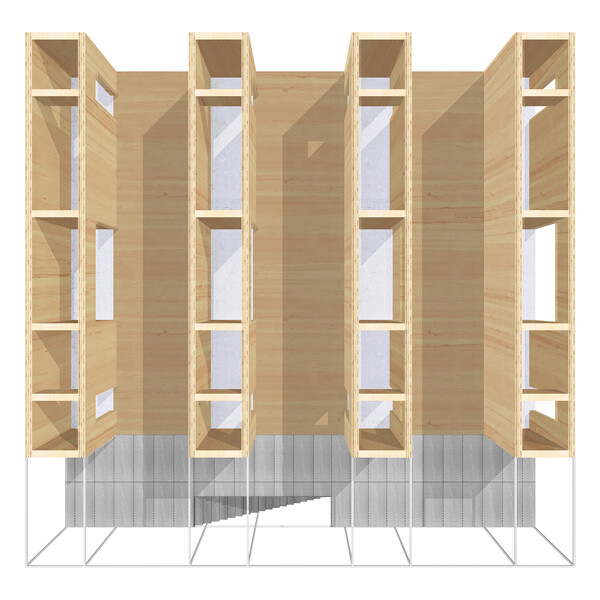

Structure, housing for Community Land Trust on Rue Démosthène, Brussels. DOGMA, Do you see me when we pass?, 2019.
Countermove 1: The Landscape of Housing Cooperatives
Where states and markets have failed to deliver housing for living in, civil society initiatives can prove more effective. Initiatives such as housing co-operatives present an alternative to private home ownership by placing limitations on the speculative value of housing. Particularly in forms like a Limited Equity Housing Cooperative (LEHC), where residents do not own their dwellings directly but rather a share of the corporation that owns the housing complex they inhabit. LEHCs differ from other cooperative arrangements because the price of the ownership shares is determined beforehand by the members of the associations themselves, and is therefore not influenced by the fluctuations of the real estate market. For example, in a Zero Equity Housing Cooperative, a type of LEHC, if residents leave, they are only allowed to receive back the entire sum they initially paid.
LEHCs were already present in America since the late nineteenth century as luxury developments called Home Clubs, but their scope evolved through time to become more politically and socially progressive.12 In order to ensure the stability of bylaws, and to prevent them from being changed for the gain of some residents over others, LEHCs usually collaborate with government agencies or land trusts to receive funding and stabilize contract conditions.
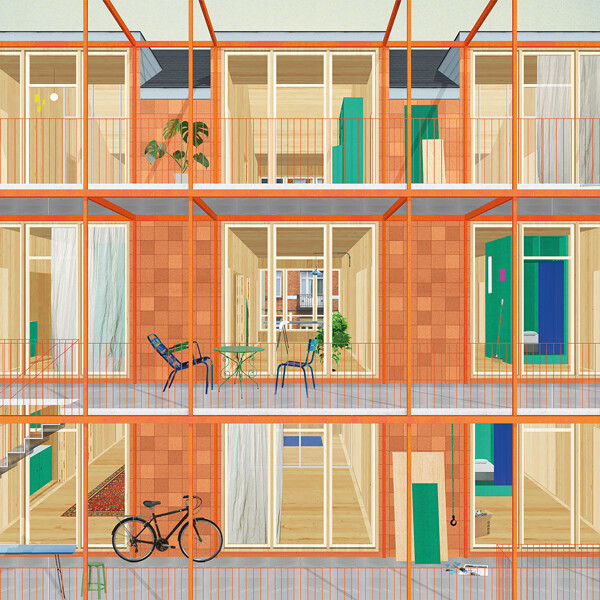

View toward the inner courtyard, housing for Community Land Trust on Rue Démosthène, Brussels. DOGMA, Do you see me when we pass?, 2019.
Another example is the German Mietshäuser Syndikat, or Syndicate of Tenements. Founded in 1992, its aim is to appropriate and reprogram existing capitalist forms of ownership by implementing a collective property of commons.13 The ownership scheme of each syndicate project is divided into two main shares of 51 and 49 percent, owned by the users/inhabitants who form the cooperative of rent-paying stakeholders and the syndicate company respectively. In this way, the residents retain autonomy over the decision-making processes regarding the development and administration of the property, while the participation of the syndicate prevents attempts at exploitation or privatization. Land and premises are therefore ring-fenced within a network of social control and secured long term as self-administered entities.14
Another important contemporary example of withdrawing housing from the market and reclaiming it as a social right is the Community Land Trust (CLT). First introduced in the United States by Robert Swann in 1969, the CLT model was conceived as a way to stem speculative development on farmlands. Since the 1980s, CLTs have also been implemented in urban areas with the aim of protecting processes of allocation, continuity, and exchange.15
The CLT model is based on the separation of land as a form of property from that of the building. Land is retained by the CLT in perpetuity, thereby preventing land speculation, while allowing housing units to be purchased with long-term ground leases. Nowadays, the model of the CLT is becoming more and more common in Western cities. It represents one of the few viable alternatives for the organizing of public lands without interference from private developers.


Two room apartment with office, housing for Community Land Trust on Rue Démosthène, Brussels. DOGMA, Do you see me when we pass?, 2019.
In many European countries, like Belgium, this model of land acquisition is still in its initial phase, largely supported by public subsidies, and therefore mainly addresses low-income populations. However, its American version is much more advanced and able to provide—in addition to housing for everyone—a multitude of communal facilities such as emergency shelters, special needs housing, and single room occupancy (SRO) housing for individuals with very low incomes.16 In Switzerland, the success of the housing cooperative movement has been supported and made possible by favorable legislation as well as financial assistance and land availability.17 In London, municipalities have initiated and supported several programs in recent years that enable small plots of land that are in the hand of public authorities to be made available for small developers, housing associations, and community-led organizations to construct alternative housing projects through long-term lease contracts.
As property prices rise, and the hegemony of finance continues to expand, it becomes increasingly difficult to acquire and finance a counter-speculative strategy for housing. In this light, contemporary forays into cooperative building should be reassessed in the neoliberal financialiszd condition. Cooperative building initiatives such as Baugruppenin Germany and Ryhmärakentaminenin Finland—where individuals self-organize to finance the construction of their buildings—appear successful in circumventing certain market mechanisms when it comes to housing. By effectively operating as their own developer, cooperative building cuts out the middleman in the development process, producing housing for below-market cost. While this process allows for the construction of alternative forms of housing and offers a degree of agency for residents in the arrangement of their domestic life, it is also limited to those with access to credit and capital. Because they operate essentially as individual business ventures, cooperative building assets are inevitably subject to some form of entrepreneurial calculus, promising either great returns on investment, or at least stable housing costs amidst skyrocketing rents. Without a mechanism to counter the speculative tendency, cooperative housing ventures risk only further entrenching the financialized condition of housing.
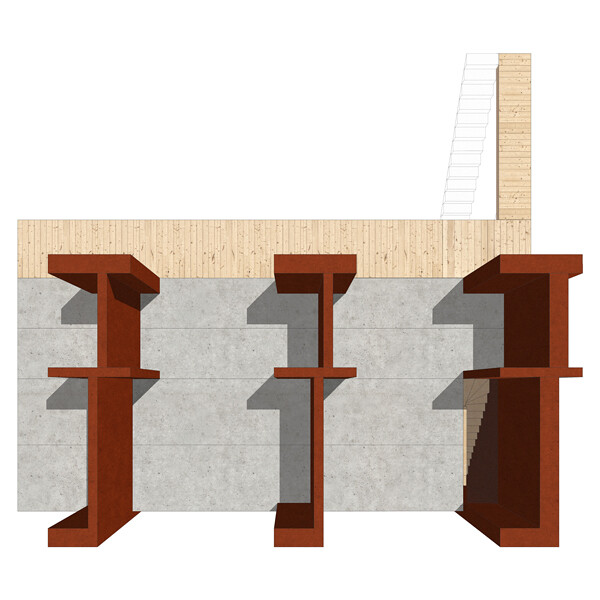

Structure, Viikinmäki, Helsinki. New Academy, 2019.
Countermove 2: Towards a New Model of Building Cooperative
If the appreciation of real estate value has been built on increasingly abstract layers of financial instruments, it is also inevitably tied to a very concrete reality of floors, walls, and roofs. Over the years, the construction industry has undergone a series of transformations in terms of sustainability, speed of construction, and technical and structural performance. Where these transformations claim to improve performance, they have also increased the complexity of buildings. At the same time, advances in prefabricated concrete and cross-laminated timber have greatly sped up the construction process, with building components arriving on site and requiring only a few days, if not hours to assemble together. Such developments have reduced overall project costs by limiting the amount of on-site labor, while also increasing the economic feasibility of long spans and reduced material thicknesses.
Such developments should not be taken lightly as indicators of progress. Indeed, the increasing sophistication and complexity of building has gone hand in hand with the agglomeration and increasing monopolization of the building industry by a limited number of players. Transformations in approaches to site management, construction, and building assemblies have served to derive efficiencies from capital investment by de-skilling construction to reduce labor costs in building. These transformations cannot be taken uncritically, and indeed reflect a long legacy of architects’ tenuous relationship with construction labor. Ever since Filippo Brunelleschi undermined the collective power of building guilds in fifteenth-century Florence, the disciplinary status of architecture has in some form always rested on its emancipation from the labor of building.18 Since contemporary construction methods increasingly rely on prefabricated and standardized components, construction companies are less builders than coordinators of labor and capital.
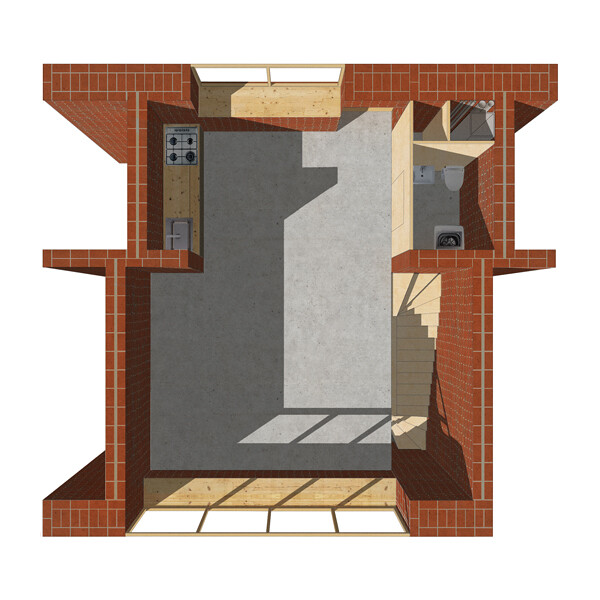

Upper level of a combined unit, Viikinmäki, Helsinki. New Academy, 2019.
Against this incumbent industry, it is worth considering the transformations towards what Nick Srnicek terms “platform capitalism.” Multi-billion dollar companies like Uber have little in terms of fixed assets but are “platforms,” operating as intermediaries enabling two or more groups to interact.19 With Airbnb, real estate is undergoing a similar transformation, as the company acts as a platform intermediary between physical space and potential users. Rebranding what are essentially real estate activities as a “platform” has generated immense speculative value. As builders increasingly act as developers and vice versa, they too have begun to create their own marketing platforms to connect their products with buyers.
In this sense, the contemporary construction industry behaves more as a platform than as an industrial model of production. Builders and developers establish capital-intensive infrastructure and production methods that allow them to operate as intermediaries, connecting a precarious and interchangeable labor force with speculative real estate assets that are sold on digital platforms. The growing platformization of the construction industry points towards one ambition: monopolization of the built environment. What we need then is to get there before they do.
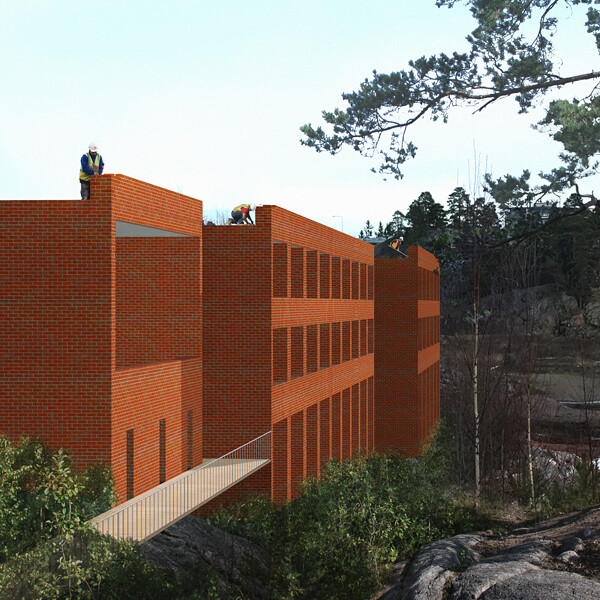

Brick parapet construction, Viikinmäki, Helsinki. New Academy, 2019.
Adapting cooperative models of construction and ownership along the lines of platform capitalism may open up new fronts to contest the speculative nature of housing. Remarking on the state of the “sharing economy,” scholar-activist Trebor Scholz identifies the rather precarious position that platform companies have been placed in. Though they boast huge market valuations, most platform companies are essentially just an app or a website that enables them to act as an intermediary. On the other side of the table, the atomized and precarious workforce of platform companies such as Taskrabbit or Foodora increasingly see through the illusion that they are liberated from the drudgery of work, and that they are rather a hyper exploited labor force at the mercy of startup and venture capital. For Scholz, workers for these platforms can coalesce and build for themselves their own app or platform that equals or outperforms their corporate equivalent.20
The increasing platformization of the economy can be an opportunity to consider a cooperative platform entrant into the real estate sector. More than isolated cooperative building initiatives, a cooperative platform can coordinate labor and capital flows at a level that can challenge incumbent construction companies. Cooperative platforms can mobilize a pool of workers building housing that is cooperatively owned and withdrawn from speculative mechanisms.
Where the shift to more capital-intensive activities has radically changed the building industry, so too would a shift towards more labor-intensive activities. Alternative forms of construction, still valued for their durability, longevity, and spatial organization, can be re-introduced outside market demands and warranties considered by construction companies. Solid brick walls, for example, can essentially last forever with proper maintenance, unlike current “brick” buildings which consist only of a surface cladding of bricks placed on top of an assembly of foam, concrete, and steel that are commonly rated for only thirty to fifty years.21
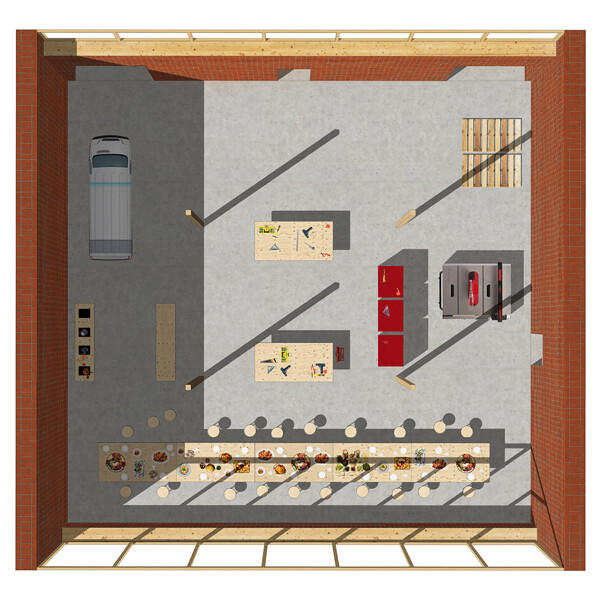

Workshop, Viikinmäki, Helsinki. New Academy, 2019.
A cooperative platform for construction enables multiple avenues through which to engage the speculative condition of housing. At the level of finance, it can mobilize and pool cooperatively-owned assets to finance the expansion of housing and its removal from the speculative market. At a certain scale, it could even leverage the attractiveness of mortgage-backed securities to establish creditworthiness, which remains an obstacle for individual cooperatives and those without access to credit or capital. In terms of politics, cooperative platforms position themselves less as activists making demands on the government than as “investors” themselves. As Michel Feher notes, “in order to compete with capitalist enterprises that dominate the so-called collaborative economy, cooperative interfaces must constitute themselves as actual investees, that is, as projects worthy of investment.”22 Cooperative building platforms can position themselves to secure incentives from municipalities who are currently powerless to build and finance their own social housing, incentives that developers have already exploited so well in the past.
In the face of growing housing unaffordability, cities are increasingly depleted of the urban life that sustains them and replaced with a “zombie city” of vacant speculative assets.23 Cooperative building—once organized as a movement fighting for access to stable housing—can become an attractive partner for cities and governments, negotiating with municipalities who are currently powerless to build and finance social housing of their own.
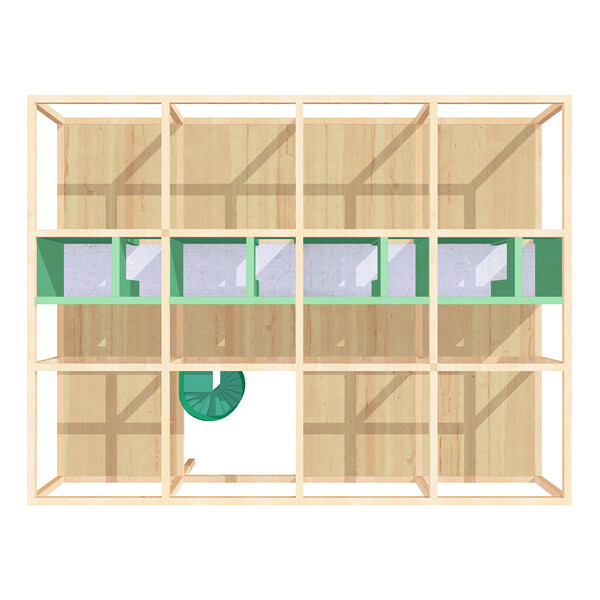

Structure, Somerleyton Road, London. DOGMA, Do you hear me when you sleep?, 2019.
Countermove 3: Challenging Domestic Space
Historically, in the West, the identification of the house with the family corresponded to the spatial separation between public and private space.24 In ancient times, public space was the space of political and social life, while private space was the space of biological reproduction, whose functioning depended on the affective and domestic labor of women and slaves. With the rise of capitalism and industrialization in the eighteenth and nineteenth century, this public/private separation was resurrected within the nuclear family to clearly distinguish work performed by the male breadwinner from the domestic labor performed by the housewife.25 While work was remunerated, domestic labor was unwaged and considered a “labor of love,” expected from the housewife for the sake of the family. Because of this domestic division of labor, in the modern home, working activities like workshops or stables were expelled from the house. This is visible in many attempts to reform domestic space in the eighteenth century, such as John Wood the Younger’s influential models for homes for the laboring classes.26
A challenge to the house as a family home came from nineteenth-century New York, where a wave of housing developments undermined the pastoral image of family dwelling. Apart from the infamous tenements for lower classes, New York was then also the city of apartments and residential hotels. To accommodate middle class immigrants to the city who could not afford single-family houses due the high cost of land, developers built the first “middle class apartments” in history.
The word apartment comes from the Latin appartare,which means “to separate” but also “to distribute in parts.” This typology of dwelling developed first within upper class residential architecture during the Renaissance as a set of rooms for the use of a single resident. When this domestic arrangement arrived in New York in the nineteenth century, however, it was immediately associated with hotel life, to the point that in designating residential buildings, the words “hotel” and “apartment” became interchangeable.
As noted by Elizabeth Collins Cromley, writers of the period did not agree on terminology and they used a variety of terms to address buildings that were made of multiple households such as “French flat” and “apartment hotel.”27 While apartments were meant to be permanent homes, apartment hotels were more for transient living. Yet typologically, these two types of buildings were very similar, if not the same. Both types offered collective spaces such as lobbies, dining rooms, parlors, and roof gardens, but also collective services such as collective kitchens and housekeeping. Even though both apartments and hotels were commercial developments, their collective nature and their lifestyle based on professionalized domestic labor challenged traditional values such as unwaged domestic work and the absolute privacy of the family household.
Hotel life quickly become widespread in US, and while it was initially limited to wealthy classes, between the end of nineteenth and beginning of the twentieth century, it was extended to middle and lower classes in the form of “mid-priced hotels,” “apartment hotels,” and “rooming houses.”28 Typologically, the residential hotel—especially in its mid-priced version—was the most anti-domestic kind of lodging, comprised of rooms for single persons, more or less all of the same size, supported by collective spaces like lobbies or restaurants. The size and type of the room was often indifferent to the gender of the occupant, even though hotels had a strict policy of class and race discrimination.
An interesting compromise between cheap hotel accommodation and the private apartment were the “single room occupancy” houses, or SROs. This typology consisted of a beehive of small rooms, sometimes equipped with a bathroom and a kitchenette, supported by collective spaces. In some cases, SRO accommodations were indistinguishable from hotel rooms, while in others, they were more similar to private apartments, especially when they included more than one room like a bedroom and a parlor. In cities like San Francisco, this typology spread extensively, to the point that entire neighborhoods such as Fillmore and South Market were made almost exclusively built of them.29


Proposal for a Cooperative House on Somerleyton Road, Brixton, London. DOGMA, Do you hear me when you sleep?, 2019.
All these housing developments were commercially initiated, yet the spread of non-domestic typologies in the US was also influenced by communitarian movements that became widespread in 1800s.30 Inspired by Charles Fourier’s idea of the Phalanstère—a social unit consisting of circa 1,600 people inhabiting a common building in egalitarian manner regardless of gender—movements such as the Perfectionists proposed a way of life based on equality and solidarity, challenging the privacy of the domestic realm. The attack on the private home was also pursued by who historian Dolores Hayden has identified as “material feminists,” questioning the isolation of women with the average family home and proposing radical models of domestic arrangements based on the socialization and professionalization of domestic labor.31
A clear example of the confluence of these movements and more pragmatic housing developments were the Home Clubs built in New York between 1883 and 1890, of which the Chelsea Hotel is the most well-known example. Conceived by the architect Philip G. Hubert, the inventor of “cooperative housing,” Home Clubs offered a variety of apartments without kitchens for singles, couples, and families, supported by a wealth of collective spaces such as lounges, meeting rooms, and collective kitchens.32 These clubs would allow families and groups of residents to afford housing at a lower rent while taking advantage of collective housekeeping and mutual support among residents. Besides introducing a new spatial model for collective living, Home Clubs were also an innovative economic model based on common property in a joint stock scheme. The Home Club was organized as a corporation of shareholders taking part in all aspects of the project.
The situation at the time was generally different in Europe where, apart from a few cases, this type of housing was not implemented at a large scale.33 During the nineteenth century, only a few examples of cooperative housing existed, especially in England,34 but the beginning of the twentieth century was marked by some significant experiments and concrete initiatives that combined cooperative housing and centralized housekeeping, from the German Einkuchenhaus(one kitchen house), to the Swedish Kollektivusand the Soviet Dom Kommuna.35
Many cooperative housing initiatives and collective hotel living projects at the time came under attack by governmental institutions responsible for housing, such as the United States social reformers of the “Progressive era.” For these reformers, cooperative and communal living was a serious threat to family values and home property.36 It was first the rise of social housing, and then of the affordable market housing that reduced cooperative housing to a marginal phenomenon. And where cooperative housing did survive, like in Germany, Switzerland, and Denmark, it is rare that the cooperative nature of the home continued to be reflected in its typological organization.37
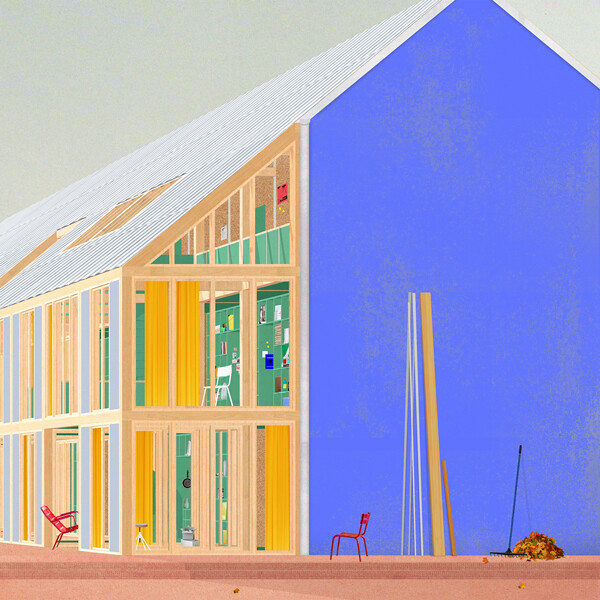

External view of typology II, Somerleyton Road, London. DOGMA, Do you hear me when you sleep?, 2019.
An exception to this trend happened in Sweden between the 1970s and 1980s. Under the pressure of the Social Democratic women’s movement and other feminist groups, several cooperative housing initiatives addressed the issue of lessening housework for women. As noted by scholar Alison Woodward, the Swedish women’s movement found its most effective architectural expression in the work of the BIG collective, a group of female architects, interior designers, and journalists who in the 1970s developed an influential concept of communal home based on three principles: small scale communities, speculation-free housing, and a varied population of tenants in terms of age and profession.38 This attempt to reform the family household towards a more cooperative system based on socialized domestic work was implemented not only in private but also in public housing.
An important example of this movement was the housing block known as Stacken, a cohousing development that was established by renovating a tower block built in 1969 in Bergsjön, Gothenburg, as part of Sweden’s Million Homes Project. The typical plan of the original tower was organized as a composition of five individual apartments served by a central core and with no collective facilities. After a few years of use, the apartments were retrofitted in order to decrease the size of the private rooms and replace the private kitchens with small kitchenette, while a wealth of collective facilities including a collective kitchen and a dining restaurant were added. In 2002, the inhabitants of Stacken formed a cooperative and bought the building from the municipality in order to refurbish it and reinforce the communal structure of the building by adding more communal spaces for care and work.39
In spite of these examples, a lot of cooperative affordable housing that tends to be built in Europe and North America often resembles traditional family housing, and where the mere existence of some shared space is but a reminder of the original communal idea. The question of family was central to neoliberal arguments against public investment and education, and key to neoliberal proposals for a new economic order powered by private investment and household debt.40 Yet the recent wave of austerity measures introduced by governments since the 2007–2008 recession has seriously endangered the formation of families among new generations. This situation has convinced developers and city authorities in many European cities to drastically reduce the size of apartments in order to accommodate singles, couples, or small families.41 Even within these conditions, though, the legacy of the family household is still strong. Each housing unit, no matter how small, has to remain self-sufficient, and thus still a private home. As such, many developers have begun pushing for “mini” apartments that are below regulation size—ostensibly in response to changing demographics and rising housing prices.
Projects such as Sato’s StudioHome, a communal housing project in Helsinki working with these measures, promises “affordable” rents, but actually allows developers to increase the per-square-meter price of their developments, since the apartments are smaller.42 Sato’s StudioHome claims to make up for the shortcomings in private space by being a “communal and inclusive apartment building” with shared facilities and even a community “manager” in charge of increasing social interaction between residents. Similar strategies have already been deployed by private companies like WeLive and The Collective, which offer accommodation in a typology similar to the old commercial residential hotel, but unlike the latter, are pumped with an overdose of rhetoric about living collectively and a premium rate.43 These companies target generally young professionals, the much-celebrated (and much-exploited) “Millennials,” while they exclude people in most urgent need of these types of dwellings, such as the disabled and elderly.
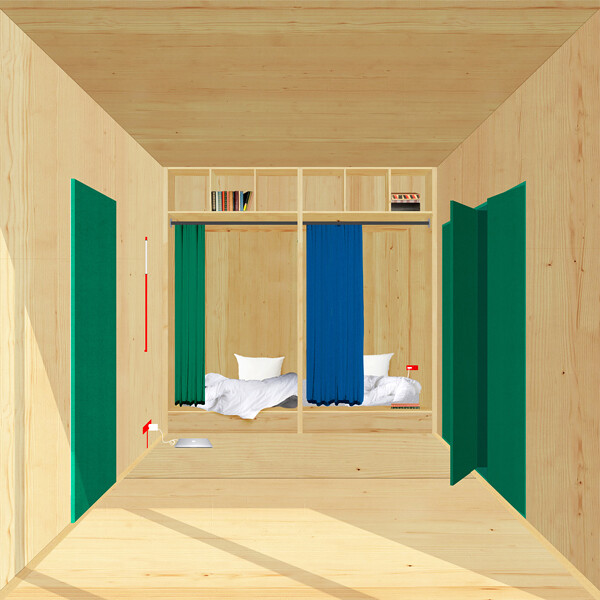
Double room with alcove, housing for Community Land Trust on Rue Démosthène, Brussels. DOGMA, Do you see me when we pass?, 2019.
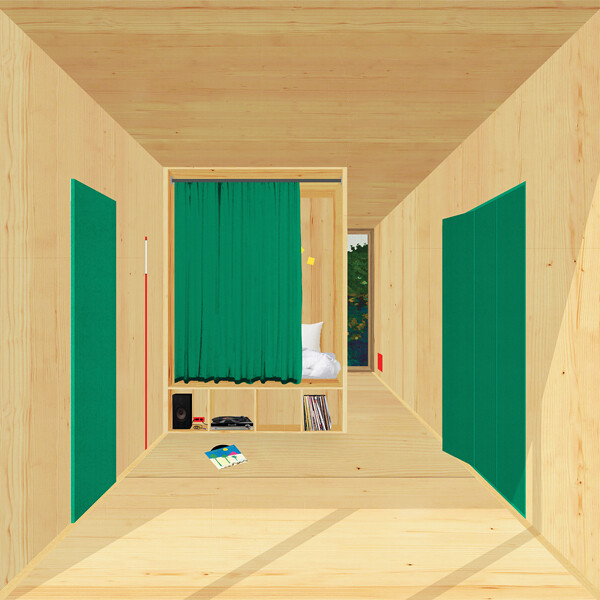
Interior view with alcove, housing for Community Land Trust on Rue Démosthène, Brussels. DOGMA, Do you see me when we pass?, 2019.

Interior view with office, housing for Community Land Trust on Rue Démosthène, Brussels. DOGMA, Do you see me when we pass?, 2019.
Double room with alcove, housing for Community Land Trust on Rue Démosthène, Brussels. DOGMA, Do you see me when we pass?, 2019.
From Commodification to Cooperation
There has always been a strong relationship between systems of ownership and typologies of domestic space. Specific housing typologies such as the terraced or detached single-family house have historically been used as a way to spatially organize the idea of private property as individual right. For example, in the terraced house, the spatialization of property is realized by the principle of the party wall, a load-bearing wall that cannot be perforated. In the detached home, property is embodied in the surrounding of the home by a garden. Another important typological aspect that reflects private property is access to the family, which is often provided by one entrance. This entrance leads directly to the street, in the case of the single-family home, or to the vertical core, in the case of the private apartment. The one-entrance system ensures that the house is perfectly individualized, and that there is a clear threshold between the private and the public domain. The number of rooms, their different sizes, and their hierarchical arrangement is also a potent means to reinforce a sense of property and self-sufficiency by making the house appear complete in itself. In the case of the micro-flat, the fact that all the services of a normal flat, including kitchen and bathroom, are squeezed into a hotel-like room makes it clear that the room is a privately-owned apartment, and not a unit of a larger communal house.
With the rise of home property in the postwar period, it has become nearly impossible to advance radical changes into the way that housing is owned, built, and typologically organized. This has led some researchers to define the problem of housing in terms of “obduracy.”44 Not only are domestic habits extremely enduring and hard to change—since they give a sense of orientation (especially within uncertain times)—but when we talk about houses, we talk about a system in which a specific spatial condition is linked to social and juridical frameworks that are deeply engrained in people’s mentality. It is for this reason that the most urgent task is not to produce “new typologies” or smarter homes, but to connect in a strategic manner alternative forms of ownership with specific typological arrangements that aim to reinforce a sense of trust and solidarity among dwellers.
It goes without saying that transformation of the home from commodification to cooperation cannot be just a “bottom-up” initiative. Those involved in this process will have to bargain with the state for more than just incentives or subsidies. Changes in typology and ownership can only happen if at state-level there is the possibility to reform how property rights are used to commodify everything, even basic necessities. Only in this way can the provision of both affordable and social housing also be the withdrawal of the home from the market, and move towards the idea of housing as universal human right.
Marx famously addressed the landlord’s legal theft of land as the “primitive accumulation of capital.” See Karl Marx, “Part Eight: So-Called Primitive Accumulation,” in Karl Marx, Capital: A Critique of Political Economy: Volume One, trans. Ben Fowkes (London: Penguin, 1992), 873–942.
See Gary Fields, Enclosure: Palestinian Landscapes in a Historical Mirror (Los Angeles: University of California Press, 2017), 33.
Ibid., 115–16.
See Josh Ryan-Collins, Toby Lloyd, and Laurie Macfarlane, Rethinking the Economics of Land and Housing (London: ZED, 2016), 30.
See Ibid., 30.
Ibid., 25.
Ibid., 25.
Saskia Sassen, “Expanding the Terrain for Global Capital: When Local Housing Becomes an Electronic Instrument,” in Manuel B. Aalbers, ed., Subprime Cities: The Political Economy of Mortgage Markets (Hoboken: Blackwell, 2012), 78.
See Ivan Ascher, Portfolio Society: On the Capitalist Mode of Prediction (New York: Zone Books, 2016).
Ibid., 74.
UN General Assembly, Resolution 34/51, Report of the Special Rapporteur on adequate housing as a component of the right to an adequate standard of living, and on the right to non-discrimination in this context, A/HRC/34/51 (January, 18 2017), https://undocs.org/A/HRC/34/51.
See James DeFilippis, Unmaking Goliath: Community Control in the Face of Global Capital (Routledge: New York, 2004).
Dogma and Realism Working Group, Communal Villa: Production and Reproduction in Artist’s Housing (Leipzig: Spector Books, 2015), 82–83.
Ibid.
See Robert S. Swann, Shimon Gottschalk, Erick S. Hansch, and Edward Webster, The Community Land Trust: A Guide to a New Model for Land Tenure in America (Cambridge: Center for Community Economic Development, 1972).
See James DeFilippis, Unmaking Goliath.
Sylvia Claus, “The impressive development of Housing Cooperatives in Zurich,” ed. Dominique Boudet, New Housing in Zurich: Typologies for a Changing Society (Zurich: Park Books, 2017), 17–27.
See Pier Vittorio Aureli, “Do You Remember Counterrevolution?: The Politics of Filippo Brunelleschi’s Syntactic Architecture,” AA Files 71 (2015): 147–65.
See Nick Srnicek, Platform Capitalism (Cambridge: Polity Press, 2017).
Trebor Scholz, “Platform Cooperativism vs. the Sharing Economy,” Medium, December 5, 2014, https://medium.com/@trebors/platform-cooperativism-vs-the-sharing-economy-2ea737f1b5ad#.575nndfdq.
“How Long Do Buildings Last?” RDH Building Science, January 28, 2015, https://www.rdh.com/blog/long-buildings-last/.
Michel Feher, Rated Agency: Investee Politics in a Speculative Age (New York: Zone Books, 2018), 191.
See Niklas Maak, Living Complex: From Zombie City to the New Communal (Munich: Hirmer, 2015).
On the separation between public and private space and its consequences on domestic space, see Michael McKeon, The Secret History of Domesticity: Public and Private Division of Knowledge (Baltimore: John Hopkins University Press, 2005).
See Maria Mies, Patriarchy and Accumulation on a World Scale: Women in the International Division of Labor (London: Zed Books, 2014), 74–75.
See Daniel Maudin, “Habitations of the Laborer: Improvement, Reform and the Neoclassical Cottage in Eighteenth-Century Britain,” Journal of Design History 23, Model, Method, and Mediation in the History of Housing Design (2010): 7–20.
Elizabeth Collins Cromley, Alone Together: A History of New York’s Early Apartments (Ithaca: Cornell University Press, 1990), 5–6.
Paul Groth, Living Downtown: The History of Residential Hotels in the United States (Los Angeles: University of California Press, 1994), 38. See Anna Puigjaner, “Bringing the Kitchen Out of the House,” e-flux Architecture, Overgrowth, https://www.e-flux.com/architecture/overgrowth/221624/bringing-the-kitchen-out-of-the-house/.
Ibid., 60.
See Dolores Hayden, Seven American Utopias: The Architecture of Communitarian Socialism (Cambridge: MIT Press, 1976).
See Dolores Hayden, Grand Domestic Revolution (Cambridge: MIT Press, 1976).
Ibid., 65.
See Anatole Kopp, Town and Revolution: Soviet Architecture and City Planning 1917–1935 (New York: George Braziller, 1970).
An early example of cooperative housing in Europe was Ebenezer Howard’s cooperative “quadrangles,” which he proposed as part of his reformist project for new “Garden Cities” to be built around London. Implemented at Homesgarth in Letchworth, the quadrangle was designed by Harold Clapham Lander as a communal house that combined the full privacy of the individual home with the benefits of centralized housekeeping. See Norbert Schoenauer, “Early European Collective Habitation: From Utopia to Reality,” in New Households, New Housing, ed. Karen A. Franck and Sherry Ahrentzen (New York: Van Nostrand Reinold, 1991), 50–53.
The Soviet Dom Kommuna can be considered the most extreme form of communal living and socialized domestic labour. See Ibid., 55–67.
See Charles Hoc and Robert A. Slayton, New Homeless and Old: Community and the Skid Row Hotel (Philadelphia: Temple University Press, 1984), 62–86.
See Kathrin M. McCamant and Charles R. Durret, “Cohousing in Denmark,” in Franck and Ahrentzen, New Households, New Housing, 95–126.
Alison Woodward, “Communal Housing in Sweden: A Remedy for the Stress of Everyday Life?”, in ibid., 72.
See Karin Andersson, Caroline Glabik, Ellen Persson, and Megan Prier, Hej Stacken: Project Portfolio: Design and Planning for Social Inclusion 2012/2013, January 11, 2013, https://suburbsdesign.files.wordpress.com/2013/04/stacken-portfolio1.pdf.
See Melinda Cooper, Family Values: Between Neoliberalism and the New Social Conservatism (New York: Zone Books, 2017).
More recently non-family housing typologies such as co-living are coming back, not in the form of cooperative housing, but as new speculative initiatives. In recent years, in cities like London, New York and San Francisco where land and housing prices are very high, home property based on a mortgage is no longer affordable for middle-class and rental units have returned as the most profitable means of housing speculation. This condition is affecting younger generations in particular, whose budget and increasingly precarious existence do not allow them to afford mortgages or home property. This new wave of housing for rent has dramatically reduced housing size to the bare minimum. Typologies like micro-housing or micro-flats which consist of one room units inclusive of bathroom and micro-kitchen are on the rise, and often marketed as some form of hotel living—yet, unlike their late 19thcentury predecessors, they are extremely expensive.
“Frequently Asked Questions,” SATO StudioHome, n.d., https://www.sato.fi/en/faq-rental-apartments/studiokoti.
See Sophie Kleeman, “Absurd ‘Co-Living Space’ WeLive is Jacking Up its Prices,” Gizmodo, December 5, 2016, https://gizmodo.com/absurd-co-living-space-welive-is-jacking-up-its-prices-1789702081.
See Wouter Bervoest and Hilde Heynen, “The Obduracy of the Detached Single Family House in Flanders,” International Journal of Housing Policy 13, no. 4 (October 2013): 358–80.
Collectivity is a collaboration between e-flux Architecture and the 2019 Seoul Biennale of Architecture and Urbanism within the context of the “Collective City” thematic exhibition, and was made possible thanks to the support of the Creative Industries Fund NL.

